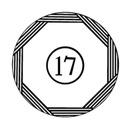Uniforms
Over the course of eight years of fighting in America, the regiment made several important modifications to its uniform and equipment. While most of the other British regiments in America also made substantial changes to their appearance during campaigns, overall the 17th’s campaign uniform appears to have been remarkably stable over the course of the war. From documentary sources such as those featured under “Documentary Extracts,” we can partially reproduce the regiment’s uniform from its garrison appearance in Ireland in 1775 through the war to Halifax in 1784.
In 1775 in Ireland, the regiment’s uniform complied with the 1768 Warrant. The Enlisted men wore full regimental coats, madder with white facings, their buttons numbered “17” and the buttonholes reinforced with regimental lace. They also wore white wool waistcoats, white wool breeches, stockings, and black “Spatterdashes” over their shoes. While the regimental inspection does not note this, it was fairly common practice for regiments to wear their waistbelts over their right shoulders, as this was a more comfortable and effective way of carrying them. For this reason, our regimental coats have two shoulder straps, each made of white facing wool, in accordance with the letter from Fauquier to Fawcett. The regiment was issued with brand new muskets (hereafter “firelocks”) from Dublin Castle, and carried the standard accouterments, viz. a waistbelt that held the bayonet and a cartridge pouch to hold their ammunition. Serjeant’s clothing was made of finer quality wool, with plain white buttonhole lace, silver lace on their cocked hats, and a sash to denote their rank. The battalion company sergeants carried halberts, pole arms with ax heads, to denote their rank. Officers had scarlet coats with white facings, silver buttons, and wore white small clothes (breeches and waistcoats), with a silver gorget and silver-laced hats. They carried silver-hilted small swords with crimson and gold sword knots.
By the 1776 campaign season, the regiment appears to have exchanged their leggings for trousers. By October of that year, regimental tailors were employed in making leggings and drawers for the men, who were to wear wool stockings and drawers with their leggings and breeches or trousers (presumably depending on the nature of the duty). Black leggings with white wool breeches, white wool waistcoats, regimental coats, and cocked hats appear to have been the regimental uniform by the time of Princeton. A similar kit was used in the winter of 1779. Research is still continuing on the regiment’s appearance during the 1777 and 1778 campaigns. Judging from evidence presented by other regiments, the 17th continued in its summer campaign attire of trousers, substituting breeches and leggings in winter.
The 1779 orderly books provide a wealth of information on the regiment’s uniform. The enlisted men wore white wool breeches with “long black leggings” as their winter uniform. Probably due to the change in command, the officers were required to make their uniforms to a new pattern and wear cocked hats, suggesting that the regiment as a whole was still in cocked hats for this period. References to knapsacks confirm their presence in the ranks.
In July 1779, the regiment was captured at Stoney Point, plundered by the rebels, and sent into captivity at Lancaster, Pennsylvania. From the scattered survivors of the debacle and recruits from England, the 17th Company under Captain-Lieutenant George Cuppiadge was formed. It appears that the regimental stores were taken at Stoney Point, so the men of the 17th Company were equipped with government-issue accouterments sets, consisting of an 18-hole cartridge box, bayonet frog, and belt. Howe’s orders in 1775 specify that cartridge boxes, also referred to as belly boxes, should be worn with a shoulder strap. Experiments in carrying accurately reproduced cartridge boxes confirm that wearing the box from the shoulder is far more effective and comfortable than wearing it on a belt. For that reason, when representing the 17th Company, we wear 18-hole cartridge boxes on shoulder straps and carry our bayonets in the government issue frog with belt, slung over our right shoulders.
In late 1780 and early 1781, the regiment was exchanged from captivity. Since the 17th Company was outfitted with government accouterment sets, and the regimental inspection of 1784 does not indicate a re-supply of cartridge pouches and waistbelts until 1782, we presume that the exchanged portions of the regiment also carried their accouterments in the same manner as that proposed for the 17th Company. For extra information on uniforms for the 1781 campaign, we gathered information from the 43rd Regiment of Foot’s orderly book. This information supports the use of trousers as well as a severely limited set of necessaries, and is the basis for our 1781 Virginia
Campaign impression. For our 1781 impression, we wear the unaltered regimental coat, with a white wool waistcoat, Russia Drill overalls, and a cocked hat. The lack of information on the 43rd’s headgear suggests that no major changes were made to it. While many other units have chosen to wear round hats for their late-war kit, we believe there is insufficient information to indicate that all battalion companies wore them and have therefore chosen to retain our cocked hats.
Our camp equipage was fairly stable and in line with the remainder of the army. For the 1776 campaign, the regiment had tents and camp kettles, the latter of which they retained for the war. During parts of the 1777 and 1781 campaigns, they apparently built brush shelters. Clayton’s company uses camp kettles and a combination of tents and brush shelters, depending on which is more accurate for the given scenario.
Caption: The 17th Regiment of Infantry Members at Historic Stoney Point Battlefield - July 2019






